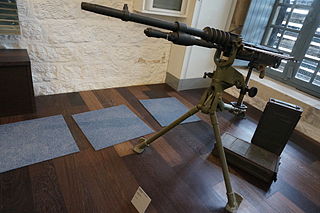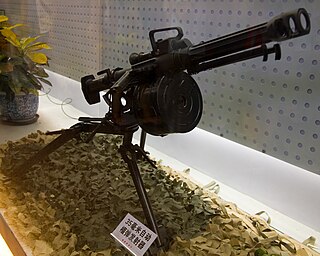Infantry support guns or battalion guns are artillery weapons designed and used to increase the firepower of the infantry units they are intrinsic to, offering immediate tactical response to the needs of the unit's commanding officer. They typically have short, low-velocity barrels, and light construction carriages, allowing them to be more easily manoeuvered on the battlefield. They are generally used for direct fire, rather than the indirect fire of other types of artillery. Their role has generally been replaced by tanks using tank guns, infantry fighting vehicles using autocannons, other combat vehicles, mortars, recoilless rifles, rocket-propelled grenades and shoulder-launched missiles.

A recoilless rifle, recoilless launcher or recoilless gun, sometimes abbreviated to "RR" or "RCL" is a type of lightweight artillery system or man-portable launcher that is designed to eject some form of countermass such as propellant gas from the rear of the weapon at the moment of firing, creating forward thrust that counteracts most of the weapon's recoil. This allows for the elimination of much of the heavy and bulky recoil-counteracting equipment of a conventional cannon as well as a thinner-walled barrel, and thus the launch of a relatively large projectile from a platform that would not be capable of handling the weight or recoil of a conventional gun of the same size. Technically, only devices that use spin-stabilized projectiles fired from a rifled barrel are recoilless rifles, while smoothbore variants are recoilless guns. This distinction is often lost, and both are often called recoilless rifles.

The Carl Gustaf 8.4 cm recoilless rifle is a Swedish developed 84 mm (3.3 in) caliber man-portable shoulder-fired recoilless rifle, initially developed by the Royal Swedish Army Materiel Administration during the second half of the 1940s as a close-range anti-tank and support weapon for infantry, which has seen great export success around the globe and is today a popular multi-purpose support weapon in use by many nations. The Carl Gustaf 84 mm recoilless rifle is a lightweight, low-cost weapon that uses a wide range of ammunition, which makes it extremely flexible and suitable for a wide variety of roles.

This article is about the weapons used in the Vietnam War, which involved the People's Army of Vietnam (PAVN) or North Vietnamese Army (NVA), National Liberation Front for South Vietnam (NLF) or Viet Cong (VC), and the armed forces of the China (PLA), Army of the Republic of Vietnam (ARVN), United States, Republic of Korea, Philippines, Thailand, and the Australian, New Zealand defence forces, and a variety of irregular troops.
The M1917 Browning machine gun is a heavy machine gun used by the United States armed forces in World War I, World War II, the Korean War, and the Vietnam War; it has also been used by other nations. It was a crew-served, belt-fed, water-cooled machine gun that served alongside the much lighter air-cooled Browning M1919. It was used at the battalion level, and often mounted on vehicles. There were two main iterations: the M1917, which was used in World War I and the M1917A1, which was used thereafter. The M1917, which was used on some aircraft as well as in a ground role, had a cyclic rate of 450 rounds per minute. The M1917A1 had a cyclic rate of 450 to 600 rounds per minute.

The Mle 1914 Hotchkiss machine gun chambered for the 8mm Lebel cartridge became the standard machine gun of the French Army during the latter half of World War I. It was manufactured by the French arms company Hotchkiss et Cie, which had been established in the 1860s by American industrialist Benjamin B. Hotchkiss. The gas-actuated Hotchkiss system was first formulated in 1893 by Odkolek von Ujezda and improved into its final form by Hotchkiss armament engineers, American Laurence Benét and his French assistant Henri Mercié.

The M40 recoilless rifle is a portable, crew-served 105 mm recoilless rifle made in the United States. Intended primarily as an anti-tank weapon, it could also be employed in an antipersonnel role with the use of an antipersonnel-tracer flechette round. The bore was commonly described as being 106 mm caliber but is in fact 105 mm; the 106 mm designation was intended to prevent confusion with incompatible 105 mm ammunition from the failed M27. The air-cooled, breech-loaded, single-shot rifle fired fixed ammunition and was used primarily from a wheeled ground mount. It was designed for direct firing only, and sighting equipment for this purpose was furnished with each weapon, including an affixed spotting rifle.

The B-10 recoilless rifle is a Soviet 82 mm smoothbore recoilless gun. It could be carried on the rear of a BTR-50 armoured personnel carrier. It was a development of the earlier SPG-82, and entered Soviet service during 1954. It was phased out of service in the Soviet Army in the 1960s and replaced by the SPG-9, remaining in service with parachute units at least until the 1980s. Although now obsolete it was used by many countries during the Cold War.

The M20 recoilless rifle is a U.S. 75 mm caliber recoilless rifle T21E12 that was used during the last months of the Second World War and extensively during the Korean War. It could be fired from an M1917A1 .30 caliber machine gun tripod, or from a vehicle mount, typically a Jeep. Its shaped charge warhead, also known as HEAT, was capable of penetrating 100 mm of armor. Although the weapon proved ineffective against the T-34 tank during the Korean War and most other tanks, it was used primarily as a close infantry support weapon to engage all types of targets including infantry and lightly armored vehicles. The M20 proved useful against pillboxes and other types of field fortifications.

The Type 98 (PF-98) is a 120mm unguided anti-tank rocket system developed by Norinco for the People's Liberation Army as a successor to the Type 65 and Type 78 recoilless guns. It is also known by its nickname, "Queen Bee". It can be equipped with a firing control system which predicts the future aiming point based on calculations before the rocket fire.

The QLZ-87 35 mm automatic grenade launcher (AGL) is an air-cooled, gas operated fully automatic weapon and is crew transportable (12~20 kg) with limited amounts of ammunition. Unusual for handheld grenade launchers, the QLZ-87 fires 35x32 mmSR high-velocity grenades, which provides longer range and flatter firing trajectory.
The following is a list of infantry equipment of the People's Liberation Army of China'.

The Cambodian Civil War was a conflict between the forces of the Communist Party of Kampuchea and the royal forces of the Kingdom of Cambodia from 1967 to 1970, then between the National United Front of Kampuchea and the Khmer Republic from 1970 to 1975.

The M18 recoilless rifle is a 57 mm shoulder-fired, anti-tank recoilless rifle that was used by the U.S. Army in World War II and the Korean War. Recoilless rifles are capable of firing artillery-type shells at reduced velocities comparable to those of standard cannon, but with greater accuracy than anti-tank weapons that used unguided rockets, and almost entirely without recoil. The M18 was a breech-loaded, single-shot, man-portable, crew-served weapon. It could be used in both anti-tank and anti-personnel roles. The weapon could be both shoulder fired or fired from a prone position. The T3 front grip doubled as an adjustable monopod and the two-piece padded T3 shoulder cradle could swing down and to the rear as a bipod for the gunner. The most stable firing position was from the tripod developed for the water-cooled Browning M1917 machine gun.

Man-portable anti-tank systems are traditionally portable shoulder-launched projectile systems firing heavy shell-type projectiles, typically designed to combat protected targets, such as armoured vehicles, field fortifications and at times even low-flying aircraft.
The DZJ-08 is a portable, disposable, unguided, shoulder-launched, multipurpose recoilless weapon. The weapon is designed as a multi-role assault weapon aiming to provide anti-armor, anti-fortification, and anti-personnel capability.

This is a timeline of the war in Donbas for the year 2021.












